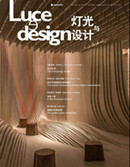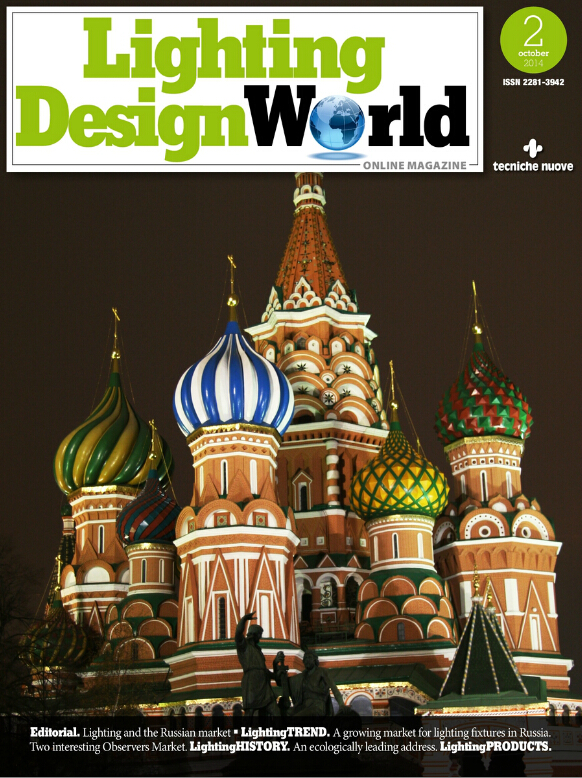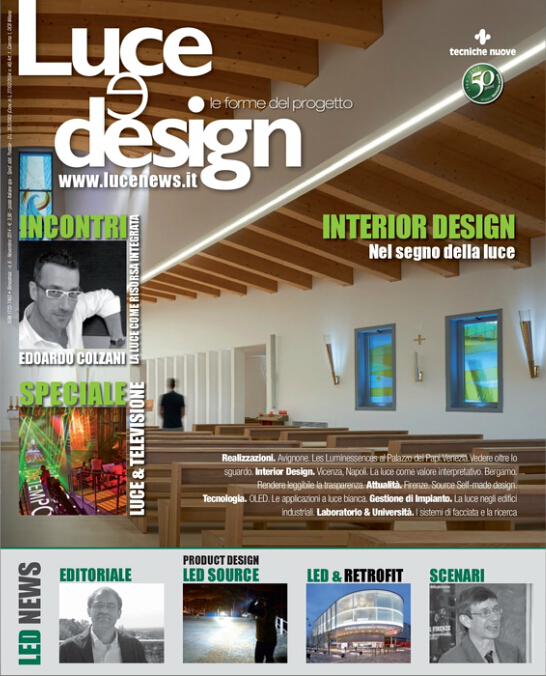文:娄娜· 兰谱斯
by Luana Lampis
米兰的历史博物馆的新照明面貌:一座受尊重和赞赏的19世纪建筑的杰出的典范
图1:米兰,Bagatti Valsecchi博物馆,安装新照明后的餐厅(图片提供:Leo Torri)
Picture 1: Milan, Bagatti Valsecchi Museum. The dining room after the new lighting installation (Photo courtesy: Leo Torri)
19世纪后期的米兰贵族福斯托(Fausto)兄弟和朱塞佩(Bagatti Valsecchi),决定在米兰的中心建立自己的宫殿。宫殿的设计灵感来自伦巴第16世纪贵族住宅,其室内装饰着文艺复兴时期的艺术品和古董家具。如今这个宫殿已成为欧洲最重要的也是保存非常完好的博物馆,馆内文艺复兴时期的收藏品按19世纪展览会的风格陈列着,如:木材和帆布画,雕塑和木制家具,武器和装甲,陶瓷和玻璃制品,黄金和象牙制品,金属和挂毯(图1)。
设计目标
Bagatti Valsecchi 博物馆照明设计的主要目标是为了突出这一伟大的建筑艺术遗产。房间装饰华丽,木制方格天花板,木材或挂毯装饰的墙壁,以及镶花地板,在没有更新照明装置之前,给人以精致华丽的印象。不过,因为光线不足,华丽的装饰只能被部分地展现出来。照明工程项目的早期概念是,博物馆最初只希望有一个样板间,以便能找出博物馆有些操作上的关键问题,同时希望为博物馆的照明系统找出一个适当的解决方案。第一个房间方案是非常重要的,因为它包含的是所有主项目上的主题(图2)。现有的照明系统是根据当时的语言学的理念形成的,但被证实这并不适合现代化的博物馆。因为现在的照明系统,不能突出装饰华丽的房间和建筑、艺术元素,如木制方格天花板,给参观者一种“平面”的环境印象。根据博物馆的要求,一方面是设置适当的照度,以便将房间里的一切完美地呈现,另一方面是提升家具的视觉效果,突出参观者最有兴趣的建筑和艺术元素。照明设计师建议使用具有高度显色性的光源,强调建筑与家具的材质色彩。
图2: 红色室:为了能找出问题和解决办法的样品室
Picture 2: The Red Room: Sample room set up to identify problems and solutions
| 项目问题
Problems encountered |
解决方案
Proposed solutions |
|
| 1 | 木格子的天花板房间高处光线暗淡
Coffered ceilings/upper zone of the rooms poorly lit |
天花板光线增加,突出细节
Increase lighting of the ceiling in order to highlight the detail |
| 2 | 吊灯光度很强
Chandelier with strong light radiating from the light sources |
平衡光流
Balance the flow of light: 降低下面的光流 Reduce the light flow below 添加组光源照亮天花板 Add a component to shine light upwards to illuminate the ceiling |
| 3 | 过度闪烁,天花板光线暗淡,影响视觉效果
Excessive dazzle that limits the view of the poorly lit ceiling |
减少房间下部的光线 Reduce the level of light below 增加墙灯,以减少对比 |
| 4 | 房间部分的光线不足
Parts of the room are poorly lit |
对特别有趣的地方,使用射灯突出细节
Use spot lighting to highlight detail of particular interest |
| 5 | 装饰和建筑的重要细节不突出
Important decorative and architectural detail not effectively accentuated |
使用射灯突出有趣的部位
Use spot lighting to highlight detail of particular interest |
表1:改善照明的问题和提出的解决方案
Table 1: The individual problems and the proposed solutions to improve the lighting
项目阶段
设计方案遇到了一些困难,由于工作的地方是在具有高度艺术价值的建筑内,有些修改,几乎不可能不损毁一些装饰。
最初的样板房间草案初稿确定三个阶段的标准:用新的灯光源取代现有在壁灯和古董吊灯的光源;在博物馆大部分的房间内,用特制的LED玻璃扩散器以增强较果;新的可调 LED 射灯一体化使用,突出艺术作品和美化灯火艺术(图3)。
图3:博物馆照明计划里的房间和改造类型:取代原光源(蓝色和绿色)和新的(红色)LED 灯板
Picture 3: Plan of the museum showing the areas and types of intervention: Substitution of the bare light sources (blue and green) and the new LED boards (red)
第一阶段,先将现有裸灯泡灯具的分类。为了突出木质镶板的效果,设计师选择新的卤素光源(18W,电源电压 E14灯头)与暖色温度(2800K)取代现在的荧光灯。
第二阶段,也是最微妙和关键的阶段,需要修改一些现有的玻璃灯,同时避免任何损害或破坏玻璃灯的美感。烛台结构是一系列的玻璃扩散器,每个玻璃的光分散器内是一个荧光灯光源。设计师首先对玻璃扩散器进行研究和分类,按照大小和形状编排(图4)。这些数据,是用来确定最合适的光源,和保证光线照射的方向,及最佳的显色度,同时光线能均匀照射在的天花板上。
图4:突出和编目不同的玻璃分散器
Picture 4: Highlighting and cataloguing the different glass diffusers of the existing lights
还有设计师决定使用高光度和双面 LED 的灯板,每个灯板都有不同的 LED 数量。其中一个主要设计,是用相对小量的 LED 在灯板的底部,把分散器的用途充份显示出来,同时限制其光线水平,以避免过强的光线影响参观者的视觉。早期的分散器分类,确定为 LED 灯板分为三种形式:小型,中型和大型,各自的功率为7、17和30 W,选择的色温度在2800 K,以保证最佳的显色性和材料的色彩。
先制造了几个 LED 灯板原型,在现场测试时以确定和解决有关的布线和 LED灯板的装配,并确保简单快捷的安装。迄今为止,前两个阶段已大致完成,空间感觉的效果和想象有很大不同(图5a-b)。虽然现在能够清楚看到房间的细节和不同房间的颜色,但对游客来说没有任何明显的变化。房间好像和以前一样,只是现在可以分辨出结构复杂的装饰和细节。维护博物馆的艺术遗产的原始特征是这个项目的最佳的结果。
图5a–b:荣誉馆前(一),后(二)对原有灯,壁灯所做的工作(图片提供:Leo Torri)
Picture 5: The Hall of Honour before (a) and after (b) the work done on the original lamps and sconces (Photo courtesy: Leo Torri)
工作进行中…
第三个,也就是最后的工作,或者说在部分的房间里,把灯光照明融入到特别感兴趣的艺术品和家具上,仍处于开发阶段。可调控的射灯和建筑照明在有特别需要时才着手制造。目前仍然在商量安装灯具的具体地方,在飞檐和沿门门楣上何处放置,以最大限度地减少安装空间。新的装置也方便与其它设备(如监控摄像机和应急照明)的整合,把大部分设备(见图6)隐藏起来。
图6:定制的机柜,兼容纳其他辅助系统(图2,3,4,6图片提供:梅蒂斯照明)
Picture 6: Accent light with special enclosure that can also house other auxiliary systems and the current situation (Picture 2, 3, 4, 6 courtesy : Metis Lighting)
In the heart of Milan, the Fausto brothers and Giuseppe Bagatti Valsecchi, who were part of the late 19th century Milanese nobility, decided to build their own palace, which was based on the aristocratic 16th century residences in Lombardy, the interior being adorned with renaissance art and antique furnishings. Today the palace is one of the most important and well preserved museum homes in Europe, where the renaissance collections are assembled in adherence to the 19th century exhibition style: paintings on wood and canvas, sculptures and wooden furniture, weapons and armour, ceramics and glass, gold and ivory, processed metals and tapestries (picuture 1).
The design objectives
The objective of the lighting design project for the Bagatti Valsecchi Museum was to highlight the great artistic heritage of the building. The rooms were richly furnished, with wooden coffered ceilings, walls in wood or with tapestries, and parquet floors. The impression prior to the installation of the new lighting was that of sumptuous detail that could, however, only be partly appreciated because of the poor lighting conditions. The new lighting project came about as a result of a request by the Museum for a project proposal to set up a sample room, with a view to identifying critical issues and defining appropriate solutions for a museum lighting system. The room that was first proposed was highly significant in that it contained all of the themes that were then developed in the executive project (picture 2). The existing lighting – probably created according to precise philological choices – proved to be unsuitable for a modern museum. It wasn’t possible to accentuate the more important architectural and artistic elements such as the beautiful wooden coffered ceilings, and at the same time it gave the impression of a rather “flat” environment. The request of the client therefore was on the one hand to set appropriate lighting levels so that everything in the room could be fully appreciated, and on the other hand to both improve the visibility of the furniture and enhance those architectural and artistic elements that are of particular interest. Added to these requests was the proposal by the lighting designers to use light sources with a high colour rendering in order to highlight the material qualities of the architecture and the furnishings.
The project phases
The design proposal encountered some difficulties given the somewhat delicate nature and high artistic value of the project framework, primarily having to work in a space that was almost impossible to modify without potentially being invasive.
Based on the criteria of the sample room a preliminary draft was prepared, which identified three phases: The substitution of the existing light sources in the sconces and the antique bare bulb chandeliers with new generation sources;The development of special boards for LED light bulbs with glass diffusers, which are present in many of the rooms; The integration of new adjustable LED spotlights in order to accentuate the lighting of works of art and furnishings of particular interest (picture 3).
During the first phrase, the existing bare bulb light fixtures were catalogued. New generation halogen light sources (18W, mains voltage E14 light socket) with a warm colour temperature (2800K) were preferred to the compact fluorescent lights being used, as they are ideal for highlighting the wood panelling.
The second and certainly the most delicate phase required some modifications to the existing glass lamps while at the same time avoiding any damage or aesthetic alteration to them. Their candelabra structure holds a series of light diffusing glass capsules, inside each of which is a compact fluorescent light source. The conformation of these glass diffusers was carefully studied and catalogued according to size and shape (picture 4). This data was then used to identify the most appropriate light source able to guarantee the correct direction of the flow of light, optimal colour rendering and a sufficient level of uniform light on the ceilings.
It was decided to use a high emission multi-LED board with lamps positioned on both sides, but with different densities. The sole purpose of the underside, with fewer LEDs, is to illuminate the diffuser and evoke its original use while limiting the level of light so as to avoid dazzling the observer. The earlier cataloguing of the diffusers identified three formats for the LED boards: small, medium and large with a respective total power output of 7, 17 and 30 W. The chosen colour temperature remains at 2800 K in order to guarantee the best perception and colour rendering of the materials.
Several prototypes were created and tested on site in order to identify and resolve issues relating to the cabling and assembly of the new boards and to ensure a quick and simple installation of all of the light bulbs. To date the first two phases are almost complete and already with this intervention the perception of the space is very different (picture 5 a-b). Although despite being able to now appreciate the rich detail and colour of the different rooms, none of the visitors is aware of any apparent change in the lighting. The general perception of the rooms is as before, only now it is possible to distinguish the intricate detail of the decoration and architecture. This is probably the best possible result for a project which was always bound by the necessity to safeguard the original features of the museum’s artistic heritage.
Work in progress…
The third and final intervention, or rather the incorporation in some rooms of accent lighting for the artworks and furnishings of particular interest, is still in development. The adjustable spotlights and the housing for them will be created on an ad hoc basis. Work is in progress to identify where to put them along the cornices and lintels of the doors so as to minimize obstructing the space. The new fixtures will also facilitate the integration of auxiliary elements (surveillance cameras and emergency lighting) allowing most of the equipment to be hidden from view (picture 6).
项目信息 Project information
项目名称 Project Name:
Bagatti Valsecchi博物馆
灯光设计Lighting Design:
Metis lighting – Marinella Patetta and Claudio Valent
LED 特殊光源供应商 LED special sources suppliers:
Light contract









































